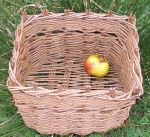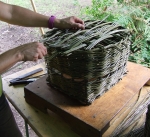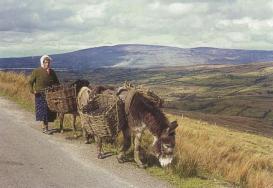 Learning how to make an Irish creel was incredibly satisfying; it was so strong and practical but had a beautiful simplistic nature to it. For starters it is made in the opposite direction to traditional stake and strand flat based baskets. The stakes are put in the ground or a jig and the top of the basket is woven first. The creel does not have a woven border; instead an incredibly tight weave called the mouth-wale is used for the first round of weaving. The stakes are trimmed some two inches above this weave at the end, it clasps the rods so hard there is no risk of it slipping off in use.
Learning how to make an Irish creel was incredibly satisfying; it was so strong and practical but had a beautiful simplistic nature to it. For starters it is made in the opposite direction to traditional stake and strand flat based baskets. The stakes are put in the ground or a jig and the top of the basket is woven first. The creel does not have a woven border; instead an incredibly tight weave called the mouth-wale is used for the first round of weaving. The stakes are trimmed some two inches above this weave at the end, it clasps the rods so hard there is no risk of it slipping off in use.
 The next stage is the knot weave which is a combination of French randing and a knot weave which is again unique to the creel. This can be very confusing to the beginner as the French randing travels clockwise around the basket and the knot weave travels anticlockwise. Each weave is used alternately. Mistakes are not easily forgiven as the work has to be undone until the ‘trapped rod’ can be freed and worked correctly. Once you get into the weave you begin to create solid side walls which are very tough.
The next stage is the knot weave which is a combination of French randing and a knot weave which is again unique to the creel. This can be very confusing to the beginner as the French randing travels clockwise around the basket and the knot weave travels anticlockwise. Each weave is used alternately. Mistakes are not easily forgiven as the work has to be undone until the ‘trapped rod’ can be freed and worked correctly. Once you get into the weave you begin to create solid side walls which are very tough.
Traditionally the Irish creel has a ‘window’ a space created by pushing the weavers a few inches above the last round of weaving. It gets tied in by the next knot weave which clasps the stakes similar to a fitch (a weave designed to grasp the stakes so it can be used to create space above or below it and not move). I guess this feature was put in because it looks good and there are a few less inches to weave!

Finally a ‘top knot’ is woven at the required height, the best I can describe it is a double pairing, which braids itself around each stake to create a firm layer which is used to thread through the be. The base I feel is the clever part, on a flat based basket the base takes proportionally a lot of time to weave certainly if you want a hard wearing base which will take your stakes tidily and evenly. On the Irish creel this part is omitted and instead the stakes become the base. On the long side (presuming it is a rectangular donkey creel) a warp is created, by folding down the stakes and threading them under the top knot. The short side stakes are woven under and over this warp. Hard work but not technically difficult. Finally there will be gaps so discarded pieces of willow can be used as ‘fillers’. All remains is the strength to pull the structure out of the ground or jig and trim the stakes.

The creel known in Irish as cliabh (pronounced cleeve) was a commonly used basket made for carrying turfs, seaweed and loads to and from market. The creel in Ireland took many forms according to what it carried and where it was made. The rectangular creels were used as donkey panniers to carry turf, also as back creels for people to carry heavy loads. A variation on the back creel was the shoulder creel, more suited to carrying loads short distances with the convenience of being easily emptied. In Western Ireland where seaweed was regularly gathered to fertilise the crops a creel was commonly made with a semi open base to let the water drain out. Similarly another clever variation called the pardog had a hinged bottom for facilitating the load falling out while the pannier remained straddled on the donkey. A clever trick to be sure.
Of course all these types of creel use all the same weaves and techniques, so once they have been learnt you can construct whatever shape or feature you require. The creel even gets close to being used as a cart, the Kish, is a creel fitted on a slide car which the horse pulled. Used up until the 1930’s it was especially used to bring down loads of turf from the mountain bogs. Eventually being replaced by the wheeled cart.
 The creel is a basket worth making today. It can be used for storing vegetables, moving vegetables, as a back carrier for wood collection (imagine going for a walk in the woods and slinging the small branches in your back creel). I have been told by Joe Hogan (the accomplished Irish basket maker who taught me) that the creel makes an excellent bike basket. I would not say it is an easy basket to make, but I have taught the creel to a range of people and find that if we give our selves enough time to go steady, the baskets secrets unfold and the troubling knot weave eventually embeds in our brains
The creel is a basket worth making today. It can be used for storing vegetables, moving vegetables, as a back carrier for wood collection (imagine going for a walk in the woods and slinging the small branches in your back creel). I have been told by Joe Hogan (the accomplished Irish basket maker who taught me) that the creel makes an excellent bike basket. I would not say it is an easy basket to make, but I have taught the creel to a range of people and find that if we give our selves enough time to go steady, the baskets secrets unfold and the troubling knot weave eventually embeds in our brains
As a land-based worker it is well worth taking the time to learn these weaves to make useful tough baskets. It is even more convenient if you grow the willow yourself. The farms in Ireland always had a sally bed in which the willow was grown. Each year it was cut as soon as the willow was dormant during November to March. The cut willow was stored for 4-6 weeks until it was semi green. This meant it had partially dried but was still flexible giving them the best of both worlds. For another 4-6 weeks the willow would remain pliable and the farming people could make all the baskets they needed for the coming year. This naturally coincided with the quiet period on the farm.

Using this window of time to the best advantage means you do not have to re-soak the willow, considering big stuff in its dried state can take more than a day per foot to soak this saves more work. These simple ways often highlight how farmers worked with nature in a symbiotic relationship that harmed little and cared a lot more. Plastic boxes are incredibly useful but if we can replace even a proportion with 100% biodegradable crates and baskets we can make and repair with our own hands then we will be doing a service to ourselves and future generations.
Ref: Basket Making In Ireland Joe Hogan